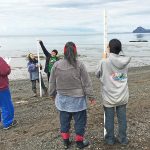Paralytic shellfish poisoning (PSP) and harmful algal blooms are a serious health risk in Alaska, and Alaska Sea Grant is deeply involved in keeping residents safe.
Some of the highest PSP toxin concentrations have been identified in the Kodiak region, where subsistence shellfish harvest is culturally and economically important. There is a strong testing program for commercial shellfish in Alaska, but no testing for personal harvest, leaving residents vulnerable to illness.
Marine Advisory agent Julie Matweyou is balancing several projects to address PSP risk in the Kodiak region. She conducted a study on shellfish toxicity in Old Harbor, which demonstrated high toxins at a popular subsistence site.
 Residents are now monitoring seawater there. She is coordinating development of a new rapid electrochemical field test kit for shellfish screening in remote locations. Matweyou has educated more than 760 students since 2012.
Residents are now monitoring seawater there. She is coordinating development of a new rapid electrochemical field test kit for shellfish screening in remote locations. Matweyou has educated more than 760 students since 2012.
One of those students, Joan Barnowsky, a 6th grader from Old Harbor, won two awards for her science fair project on PSP. She was inspired by Matweyou.
“I was interested in clams ‘cause she had a chart that shows the toxicity of the clams, and I saw that they were unsafe, so I decided to test clams myself and help the scientist,” Barnowsky said in an interview with KMXT, referring to Matweyou.
In May 2017, when a severe PSP illness broke out, Matweyou coordinated with the state to warn the Kodiak region. It’s likely that the outreach helped prevent more illnesses this year.
Harmful algal blooms (HABs) also have serious toxins, such as amnesic and diarrhetic shellfish poisoning. Alaska Sea Grant’s Ginny Eckert co-led a workshop for researchers, resource managers, industry, and shellfish harvesters to form the Alaska Harmful Algal Bloom Network. The network provides a centralized place for information on strategy and public outreach about HABs in Alaska.






